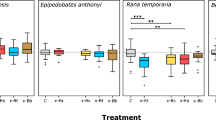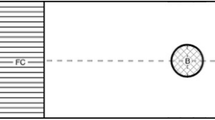Abstract
When a predators attack prey, damaged prey tissue releases chemical information that reliably indicates an actively foraging predator. Prey use these semiochemicals to cue anti-predator behaviour and reduce their probability of predation. Here, we test central mudminnows, Umbra limi (Kirtland 1840), for anti-predator behavioural responses to chemical cues in conspecific skin extract. In a field experiment, traps scented with mudminnow skin extract (alarm cue) caught fewer mudminnows than traps scented with water (control). Under controlled laboratory conditions, mudminnows showed a significant reduction in activity and movement to the bottom in response to alarm cues relative to water controls. Reduced activity and increased time on the bottom of the tank are both known components of an anti-predator response. Thus, based on field and lab data, mudminnows exhibited anti-predator behavioural responses to chemical alarm cues released by damaged epidermal tissue. Histological preparations of epidermal tissue did not reveal the presence of specialised “alarm substance” cells for the production of chemical alarm cues. This is the first report of an alarm reaction in an esociform, an order with a long evolutionary history of piscivory.





Similar content being viewed by others
References
Bry C, Basset E, Rognon X, Bonamy F (1992) Analysis of sibling cannibalism among pike, Esox lucius, juveniles reared under semi-natural conditions. Environ Biol Fish 35:75–84
Chivers DP, Smith RJF (1998) Chemical alarm signalling in aquatic predator-prey systems: a review and prospectus. Écoscience 5:338–352
Danchin É, Giraldeau L-A, Valone TJ, Wagner RH (2004) Public information: from nosy neighbors to cultural evolution. Science 305:487–491
Friesen RG, Chivers DP (2006) Underwater video reveals strong avoidance of alarm cues by prey fishes. Ethology 112:339–345
Garcia C, Rolan-Alvarez E, Sanchez L (1992) Alarm reaction and alert state in Gambusia affinis (Pisces, Poeciliidae) in response to chemical stimuli from injured conspecifics. J Ethol 10:41–46
Iger Y, Abraham M (1990) The process of skin healing in experimentally wounded carp. J Fish Biol 36:421–437
Irving PW, Magurran AE (1997) Context-dependent fright reactions in captive minnows: the importance of naturalness in laboratory experiments. Anim Behav 53:1193–1201
Kristensen EA, Closs GP (2004) Anti-predator response of naïve and experienced common bully to chemical alarm cues. J Fish Biol 64:643–652
Lima SL, Bednekoff PA (1999) Temporal variation in danger drives antipredator behavior: the predation risk allocation hypothesis. Am Nat 153:649–659
Magurran AE, Irving PW, Henderson PA (1996) Is there a fish alarm pheromone? A wild study and critique. Proc R Soc Lond Ser B 263:1551–1556
Martin-Bergmann KA, Gee JH (1985) The central mudminnow, Umbra limi (Kirtland), a habitat specialist and resource generalist. Can J Zool 63:1753–1764
Mathis A, Smith RJF (1992) Avoidance of areas marked with a chemical alarm substance by fathead minnows (Pimephales promelas) in a natural habitat. Can J Zool 70:1473–1476
Mirza RS, Mathis A, Chivers DP (2006) Does temporal variation in predation risk influence the intensity of anti-predator responses? A test of the risk allocation hypothesis. Ethology 112:44–51
Nelson JS (1994) Fishes of the world, 4th edn. Wiley, New York
Pfeiffer W (1960) Über die Schreckreaktion bei Fischen und die Herkunft des Schreckstoffes. Z vergl Physiol 43: 578–614
Pfeiffer W (1977) The distribution of fright reaction and alarm substance cells in fishes. Copeia 1977:653–665
Schutz F (1956) Vergleichende Untersuchungen über die Schreckreaktion bei Fischen und deren Verbreitung. Zeitschr vergl Physiol Psychol 38:84–135
Smith RFJ (1979) Alarm reaction of Iowa and Johnny darters (Etheostoma, Percidae, Pisces) to chemicals from injured conspecifics. Can J Zool 57: 1278–1282
Smith RJF (1982) Reaction of Percina nigrofasciata, Ammocrypta beani, and Etheostoma swaini (Percidae, Pisces) to conspecific and intergeneric skin extracts. Can J Zool 60:1067–1072
Smith RJF (1986) The evolution of chemical alarm signals in fishes. In: Duvall D, Schwarze D, Silverstein RM (eds) Chemical signals in vertebrates vol 4. Wiley, New York, pp 99–115
Smith RJF (1992) Alarm signals in fishes. Rev Fish Biol Fish 2:33–63
Tonn WM (1985) Density compensation in Umbra-Perca fish assemblages of northern Wisconsin lakes. Ecology 66:415–429
Tonn WM, Paszkowski CA (1987) Habitat use of the central mudminnow (Umbra limi) and yellow perch (Perca flavescens) in Umbra-Perca assemblages: the roles of competition, predation, and the abiotic environment. Can J Zool 65:862–870
von Frisch K (1938) Zur Psychologie des Fisch-Schwarmes. Naturwissenschaften 26:601–606
von Frisch K (1941) Über einen Schreckstoff der Fischaut und seine biologische Bedeutung. Zeitschr vergl Physiol 29:26–145
Wisenden BD (2003) Chemically-mediated strategies to counter predation. In: Collin SP, Marshall NJ (eds) Sensory processing in aquatic environments. Springer, New York
Wisenden BD, Barbour KA (2005) Antipredator responses to skin extract of redbelly dace by free-ranging populations of redbelly dace and fathead minnows. Environ Biol Fish 72:227–233
Wisenden BD, Chivers DP (2006) The role of public chemical information in antipredator behaviour. In: Ladich F, Collins SP, Moller P, Kapoor BG (eds) Communication in fishes. Science Publisher, Moscow
Wisenden BD, Smith RJF (1997) The effect of physical condition and shoal-mate familiarity on proliferation of alarm substance cells in the epidermis of fathead minnows. J Fish Biol 50:799–808
Wisenden BD, Stacey NE (2005) Fish semiochemicals and the network concept. In: McGregor PK (ed) Animal communication networks. Cambridge University Press, Cambridge
Wisenden BD, Vollbrecht KA, Brown JL (2004a) Is there a fish alarm cue? Affirming evidence from a wild study. Anim Behav 67:59–67
Wisenden BD, Klitzke J, Nelson R, Friedl D, Jacobson P (2004b) Fisheries enhancement potential and logistical constraints of using chemical alarm cues to condition hatchery-reared walleye to avoid pike odour. Can J Fish Aquat Sci 62:2144–2150
Acknowledgements
Funding was provided by faculty research grants to BDW from the MSUM College of Social and Natural Sciences. The authors thank the Steven Zissou Foundation.
Author information
Authors and Affiliations
Corresponding author
Rights and permissions
About this article
Cite this article
Wisenden, B.D., Karst, J., Miller, J. et al. Anti-predator behaviour in response to conspecific chemical alarm cues in an esociform fish, Umbra limi (Kirtland 1840). Environ Biol Fish 82, 85–92 (2008). https://doi.org/10.1007/s10641-007-9255-0
Received:
Accepted:
Published:
Issue Date:
DOI: https://doi.org/10.1007/s10641-007-9255-0




